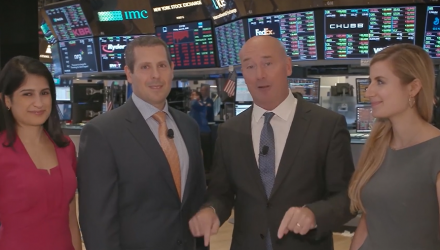Just last week, the S&P 500 became the longest bull market in history and the Nasdaq Composite just broke 8,000 points, which may have investors wondering whether they’re too late to join the party. However, by employing the right strategies given the current economic landscape, investors will be able to capitalize regardless of whether bulls or bears are prevailing in the capital markets.
This, however, begs important questions: How do I go about approaching the markets? How do exchange-traded funds fit into my current portfolio? What kind of ETFs should I look at and where is the industry going?
Helping to navigate through this seemingly vast ocean of ETF opportunities are three market experts — Yasmin Dahya, Head of Americas Beta Specialists at JP Morgan Asset Management; Samantha Azzarello, Global Market Strategist at JP Morgan ETFs; and Douglas Yones, Head of Exchange Traded Products at NYSE. Each brings their unique perspective on the latest in the capital markets as part of In The Know segment filmed at the NYSE.
Technology Still in Vogue
As far as locating opportunities in a late market cycle, Azzarello still favors tech. When investors are looking for concentrated exposure to a specific sector in U.S. equities, technology is still in vogue, especially with the market-leading FANG (Facebook, Amazon, Netflix, Google) stocks attracting war chests of investment capital.
However, investors shouldn’t just look to these FANG stocks as the sole representatives of the tech sector. While FANG stocks have reached stratospheric market valuations since the financial crisis in 2008, they’re not indicative of the technology sector as a whole where opportunity in other subareas exist.
“When we think about the US, we still like technology,” said Azzarello. “I bring that up saying that this is just not a five-company, social media story. There’s a lot happening under the surface—all of the growth momentum. I’m even thinking of biotech, right parts of health care, media, video games, there’s so much there.”
Opportunities from Abroad
Advisors shouldn’t simply point their investors to the capital markets thriving in the US, but also overseas. Despite faltering on year-to-date basis in 2018, emerging market valuations could present opportunities for savvy investors on a going-forward basis.
Related: In the Know – Stay up to date on ETF This Quarter
It’s a reminder that returns are not a simple case of “what have you done for me lately,” but an opportunity for an investor to identify “what can you do for me later.” In the case of emerging markets, there are prospects to be had that could prove potentially profitable in the future.
“Opportunities right now are abroad,” said Azzarello. “I know international markets have not done the greatest year to date so there’s some hesitation there, but these markets compared to the US have a lot more runway, their valuations are relatively cheaper, they have more earnings firepower, and they’re just earlier in their cycles.”
![]()

While investors can still capitalize on the growth of U.S. equities in their portfolios, emerging markets is able to capture a diversification aspect necessary at the current, cheaper valuations. Should U.S. equities languish, investors with capital allocated into emerging markets are potentially exposed to international opportunities where the markets are beginning to gain strength following weakness.
“With respect to emerging markets, there’s a feast-famine mentality,” said Azzarello. “Investors think that they can buy and sell and time it. Structurally going forward, we just want to have just want to have more emerging markets in that diversified portfolio because the returns over the next 10 years are expected to be higher than the previous 10.”
Foregoing Conventional Wisdom
It’s easy for investors and financial advisors to simply apply tried-and-true market strategies, but Azzarello warns that investors must change with the times. This includes foregoing conventional indexes that are market cap-weighted–a strategy that has worked for years due to central bank easing.
Whether it’s multi-factor investing or other smart beta strategies, investors have a plethora of opportunities to generate profits without simply relying on traditional methods.
“That’s not going to apply going forward,” said Azzarello. “We know across the board, returns are coming down and what that means is you have to be more selective however you do that–sectors, factors, markets you want to be in, alpha generation is going to be unbelievably important in the next 10 years.”
Smart Beta: The Intelligent Choice
With the U.S. equities market full steam ahead along with trade concerns, particularly between the United States and China, it’s provided an ideal habitat for volatility. With that volatility comes a break from the tradition of market cap-weighted investments in which portfolios are constructed based on the market capitalization sizes of various stocks.
The introduction of exchange-traded funds carved out its own niche in the financial sector, which in turn, grew exponentially and with that rise in ETFs, industry changes are abound. Yones is all too familiar with these market trends in ETFs.
Whether as a standalone investment product or a complement to an existing portfolio, Yones witnesses firsthand how investors utilize these products. Furthermore, he’s keen on where the industry is currently and where it’s headed.
Utilizing ETFs in a Portfolio
Once financial advisors arm investors with the necessary knowledge regarding ETFs, it is now up to them to identify way on how to incorporate them into an existing portfolio as complimentary products or as hedges against current investment strategies.
“People are using ETFs in a lot of different ways—both as investment vehicles, but also as trading vehicles,” said Yones. “They can express changes in the thoughts of the overall market, maybe make a small adjustment to their portfolio and they’re doing simply, easily with ETFs.”
Because of their adaptability as an investment product, ETFs have experienced exponential growth with respect to capital flows. With over $120 billion in assets flowing in, that growth is expected to only continue as more ETFs enter the marketplace.
